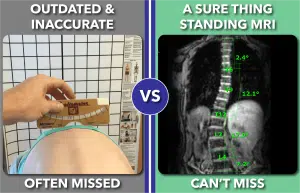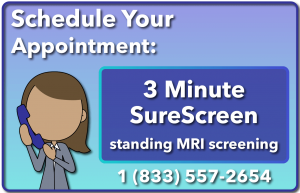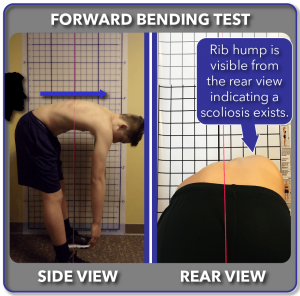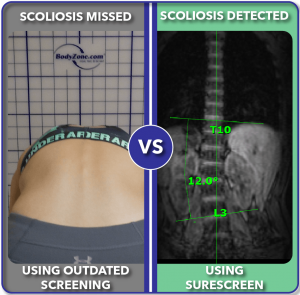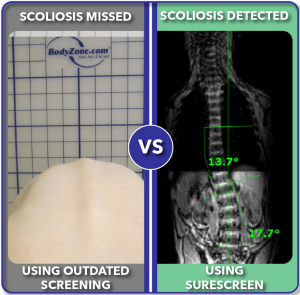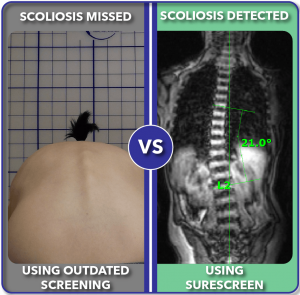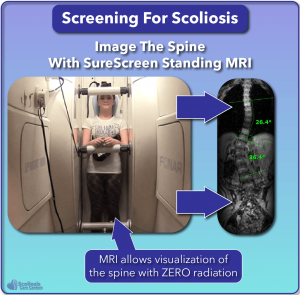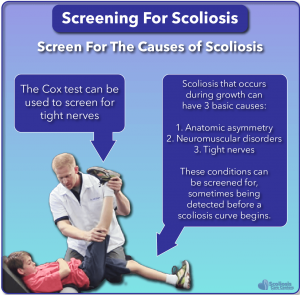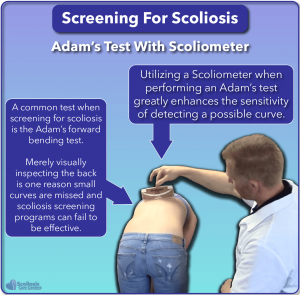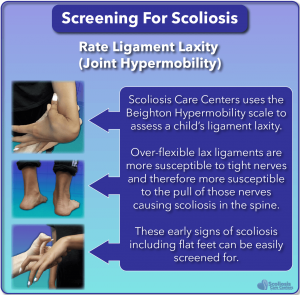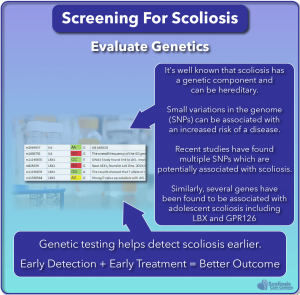Scoliosis Screening
SureScreen Standing MRI
Stop Using Outdated and Inaccurate Screening Methods
Screening children for scoliosis using visual methods can easily miss a curve, or suggest there is a curve when there isn’t one at all. While x-ray can detect a curve, it uses harmful ionizing radiation and should be avoided whenever possible.
The revolutionary SureScreen Scoliosis MRI Screening provides an accurate, 100% radiation free way of looking at the spine and detecting a scoliosis. Scoliosis screening is now a sure thing compared to the inaccurate methods of the past. If you or your child have already been diagnosed with scoliosis, you can find information about scoliosis monitoring using MRI here.
Benefits of SureScreen MRI Screening for Scoliosis
- NEVER MISS A CURVE: SureScreen uses standing MRI to actually look at the spine instead of simply looking at the surface of the back or checking for rib humps.
- EARLY DETECTION: Science shows the earlier a curve is caught and treated, the better the result 1. SureScreen allows a curve to detected when it first appears, allowing early intervention and a 100% success rate for preventing surgery when treated using the Silicon Valley Method.
- RADIATION-FREE: SureScreen is 100% radiation free in contrast to x-ray which uses ionizing radiation.
- FAST: SureScreen can be performed in just three (3) minutes, making it as fast and easy as a visual method while being a sure fire method of detecting a curve.
Old Screening Method VS SureScreen
The traditional method of detecting a scoliosis is to have a child bend forward while standing behind them to see if a rib hump is present. This method has been referred to as the “too late test” as it typically detects curves after they have already grown large in size.
The forward bending test will miss many curves when they are small. Here are real examples of real patients doing the forward bending test on the left and using SureScreenTM on the right. Even when the forward bending test looks normal, SureScreenTM can still detect the curve.
SureScreen Options
SureScreen Scoliosis Screening
SureScreen standing MRI scoliosis screening provides a quick and easy way to detect if a curve is present and how severe it is.
What is the SureScreen Plus+ Clinical Exam?
SureScreen Plus+ Looks For Root Causes of Scoliosis
SureScreen Plus+ provides the same accurate standing MRI scoliosis screen as the SureScreen but also includes a clinical examination to see if any other underlying problems are present which can cause a scoliosis to develop. This includes a tight spinal cord and nerve tension which are detected using the Cox test shown below.
SureScreen+ Uses More Accurate Traditional Screening Methods
The SureScreen Plus+ clinical exam uses traditional scoliosis screening methods such as the Adam’s test shown below, but with improved accuracy. By using additional tools such as the Scoliometer, even traditional screening methods can be improved to be more accurate.
Non-traditional Risk Assessments Supported by Science
Studies have shown that symptoms such as joint hypermobility can be associated with scoliosis 2 and risk for surgery 3. Based on this scientific and medical research, the SureScreen Plus+ clinical exam screens for ligament hypermobility; a tight spinal cord; and other warning signs of a potential scoliosis so that problems are detected early and allow early treatment and success.
Optional Genetic Testing and Analysis
SureScreen has an optional genetic analysis service which looks for known genetic variations (commonly known as SNPs) that have been associated with scoliosis in scientific research. By screening for known genetic risk factors, we can better predict if a small curve may get worse.
Frequently Asked Questions About SureScreen
What is SureScreen?
SureScreen is a ground breaking new scoliosis screening method which uses standing MRI to check for a curve in 3-dimensions without any radiation, unlike x-ray. The spine is imaged in less than 3 minutes and provides is a quick, easy, and accurate way to check if your child has scoliosis. Because SureScreen actually allows you to see the spine and observe if it is straight or has a curve, it is a sure fire way to detect a curve.
Who needs SureScreen?
100% of children between the ages of 7 and 14 years old should be screened to detect a curve as early as possible. Growing children can rapidly develop a scoliosis, especially as they go through growth spurts making screening even more important.
When is SureScreen recommended?
SureScreen is recommended once a year for children during their peak rates of growth (ages 7-14 typically).
What does SureScreen include?
SureScreen includes a postural standing MRI of the spine to determine if a scoliosis exists. A simple MRI report stating whether or not a curve is present, and the size of the largest curve measured, along with recommendations based on your unique findings is also included.
SureScreen Plus+ provides all of the above as well as an additional clinical exam which is described above.
NOTE: The report is limited to a simple determination of whether or not scoliosis is present, and does not include a detailed MRI report. For a detailed report we recommend using our ScoliSnap MRI Monitoring service.
Are there any special qualifications or restrictions?
- Typical requirements for a MRI apply: no metallic implants, recent surgeries, or other metal objects.
- Children and teens under the age of 18 are eligible for SureScreen. For adults wishing to detect and monitor their scoliosis, please see our monitoring services
Frequently Asked Billing Questions
Is SureScreen covered by my insurance?
SureScreen is typically not covered by insurance.
How much does SureScreen cost?
SureScreen costs only $98 and includes a postural MRI to detect a scoliosis as well as a simple report stating if a curve was detected, its size, and recommended actions.
SureScreen Plus+ costs $149 and includes all of the above, as well as the clinical examination described above. Genetic analysis is an optional service which can be added for an additional fee (please inquire).
All costs listed are for children and teens under the age of 18. For adult scoliosis detection and monitoring, please see our monitoring services.
Written and reviewed for scientific and factual accuracy by Dr. Austin Jelcick, PhD and Dr. Matthew Janzen, DC. Last reviewed/edited on February 27, 2020.
References
- Shakil, Halima; Iqbal, Zaheen A.; Al-Ghadir, Ahmad H. (2014): Scoliosis. Review of types of curves, etiological theories and conservative treatment. In Journal of back and musculoskeletal rehabilitation 27 (2), pp. 111–115. DOI: 10.3233/BMR-130438.
- Czaprowski, Dariusz; Kotwicki, Tomasz; Pawłowska, Paulina; Stoliński, Lukasz (2011): Joint hypermobility in children with idiopathic scoliosis. SOSORT award 2011 winner. In Scoliosis 6, p. 22. DOI: 10.1186/1748-7161-6-22.
- Haller, Gabe; Zabriskie, Hannah; Spehar, Shelby; Kuensting, Timothy; Bledsoe, Xavier; Syed, Ali et al. (2018): Lack of joint hypermobility increases the risk of surgery in adolescent idiopathic scoliosis. In Journal of pediatric orthopedics. Part B 27 (2), pp. 152–158. DOI: 10.1097/BPB.0000000000000489.

